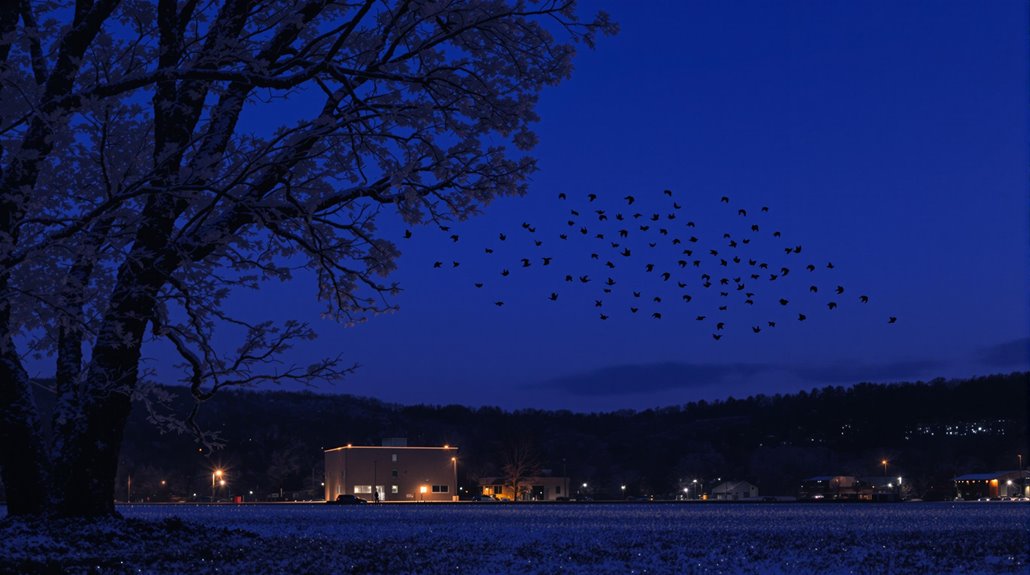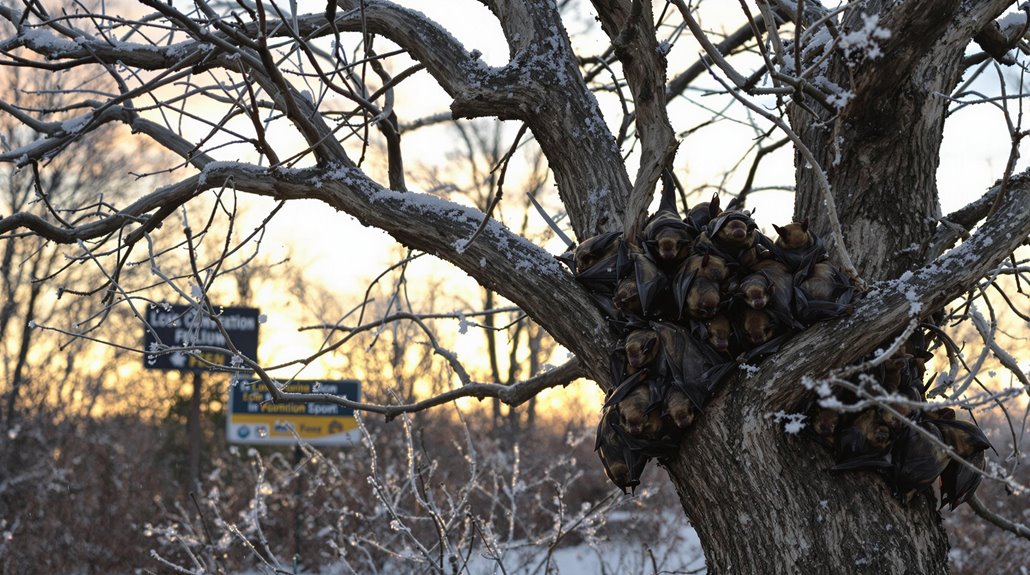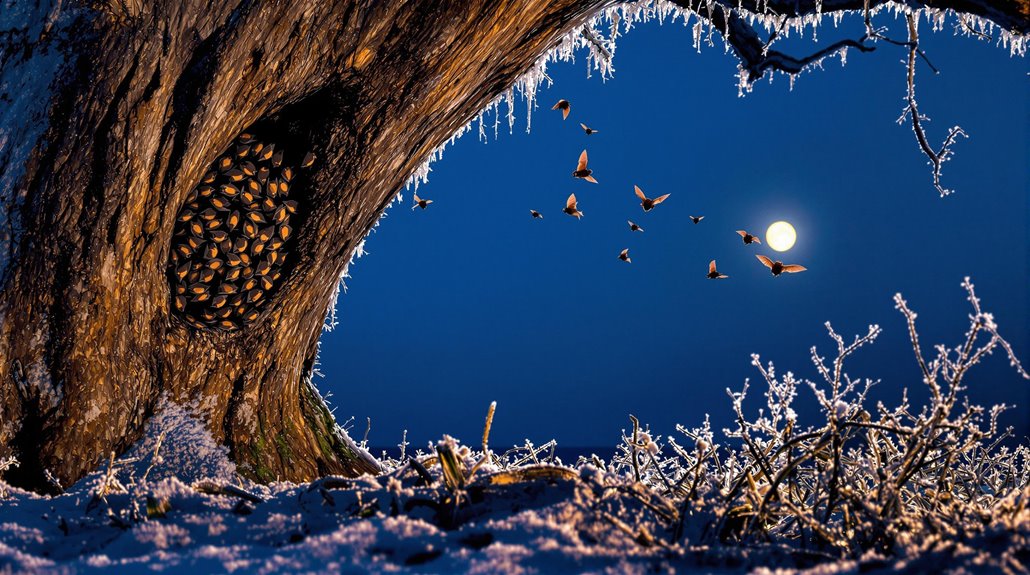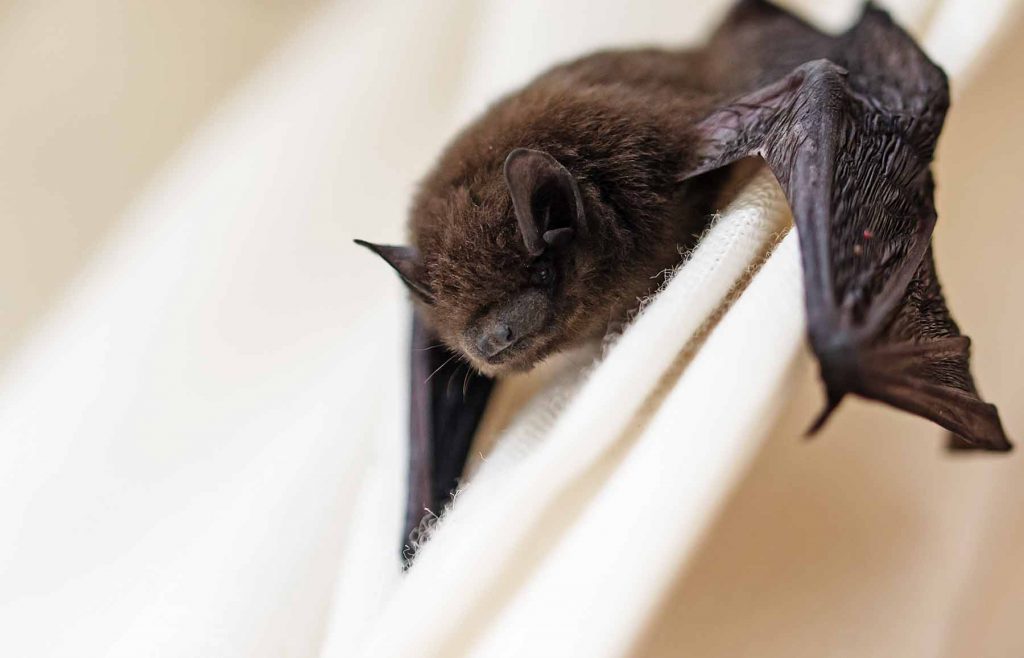Bats in Raleigh, NC, have distinct behaviors during winter. Many species, like little brown bats and big brown bats, hibernate in protective roosts. They often choose caves, tree hollows, or buildings that provide warmth. During this season, insect availability declines, so bats adjust their foraging behavior. Some may remain active on warmer days, flying at lower altitudes to find food. These adaptations are essential for their survival and contribute to pest control in the ecosystem. Interested individuals may find more insights into these fascinating creatures and their habits through further exploration.
Key Article Highlights
- In winter, bats in Raleigh, NC, may hibernate in insulated roosts like caves, mines, or buildings to survive the cold.
- Little brown bats prefer caves for hibernation, while big brown bats often roost in attics and other structures.
- During winter, insect populations decrease significantly, forcing bats to adapt their foraging strategies to find food.
- Some bats may remain active during warmer winter spells, flying at lower altitudes to locate insects near warmth sources.
- Conservation efforts and community involvement are vital to protect bat habitats and ensure their survival during challenging winter months.
Overview of Bat Species
Although bats are often associated with warm climates, they exist in a variety of species adapted to different environments. This bat species diversity allows them to thrive in many regions, including temperate zones. Bats are primarily nocturnal, meaning they are active at night. This behavior helps them avoid predators and find food, mainly insects.
In Raleigh, NC, several bat species can be found. Each species has unique traits that suit its habitat. For example, the little brown bat is known for its small size and agility in catching insects mid-flight. The big brown bat, on the other hand, is larger and can consume more insects due to its size. These bats often seek shelter in buildings or attics during the winter months, which can pose risks to homeowners if not addressed through safe bat removal.
These bats play an essential role in the ecosystem. They help control insect populations, contributing to a balanced environment. Additionally, their nocturnal habits allow them to be active when many other animals are resting. Understanding bat species diversity and their behavior helps us appreciate their importance in nature. As we learn more about these fascinating creatures, we can work towards protecting their habitats and ensuring their survival for future generations. In North Carolina, conservation efforts are crucial due to the declining bat populations caused by factors such as habitat loss and disease.
Winter Roosting Habits
Many bat species exhibit specific roosting habits during the winter months. These habits are crucial for their survival as they seek shelter from the cold. Bats often choose roosts that provide insulation and protection, allowing them to enter a state of torpor. This state helps to conserve energy as they endure the colder temperatures.
Roost selection varies among species, but many prefer caves, mines, or tree hollows. These locations offer stable temperatures and minimal disturbance. Understanding their hibernate patterns is essential for ensuring the conservation of bat populations.
The table below summarizes common winter roosting habits among some bat species:
| Bat Species | Preferred Roost Type |
|---|---|
| Little Brown Bat | Caves and Mines |
| Eastern Red Bat | Tree Hollows |
| Big Brown Bat | Attics and Buildings |
| Northern Long-eared Bat | Caves and Forests |
Foraging Behavior in Winter

In winter, bats adjust their foraging behavior to survive. They rely on specific food sources that are available during the colder months and use energy conservation techniques to maintain their health. Understanding these strategies is essential for studying bat activity in winter.
Winter Foraging Strategies
Bats exhibit unique foraging strategies during winter months to adapt to the harsh conditions and limited food resources. Many bats enter hibernation to survive the cold. Hibernation patterns vary among species, with some choosing to remain active during warmer periods. These bats utilize cold adaptation techniques to manage energy loss.
During winter, bats alter their hunting methods. They often fly at lower altitudes or near sources of warmth, such as buildings or bodies of water. This behavior helps them locate insects that may still be active. Some species may also switch to different prey that is available during the winter months, such as certain types of moths or beetles.
Additionally, bats may forage in groups. This social behavior can increase foraging efficiency by allowing them to share information about food sources. By adjusting their foraging strategies, bats can maximize their chances of finding food. Overall, these adaptations are essential for their survival in the cold, as they face the challenge of limited resources during winter. Understanding these strategies sheds light on their resilience and importance to the ecosystem during colder months.
Food Sources Availability
Winter presents significant challenges for bats as they seek available food sources. During this season, the insect population drastically decreases. Many insects are not active in the cold weather, making it hard for bats to find food. This scarcity forces bats to adapt their foraging behavior to survive.
Some bats may engage in winter migration. They move to warmer areas where the insect population is higher. This migration allows them to find enough food to sustain themselves during the winter months. In Raleigh, NC, bats face the reality of limited food sources. The mild winter temperatures may attract some insects, but overall, opportunities for foraging remain low.
Bats rely heavily on their ability to hunt insects at night. However, with fewer insects available, they must be efficient and strategic in their feeding. They may change their hunting grounds or adjust their feeding times to maximize their chances of finding food. Understanding the patterns of insect population during winter is essential for bats. This knowledge helps them navigate the challenges of winter and seek out the food sources they need to thrive. Consequently, the availability of food is critical for the survival of bats in the winter months.
Energy Conservation Techniques
Survival during the winter months requires effective energy conservation techniques, especially for foraging behavior. Bats face challenges in finding food as insects become scarce. To cope, they often use hibernation techniques. Hibernation allows bats to enter a state of deep sleep, reducing their metabolic rate and conserving energy. During this time, they rely on stored fat reserves to survive.
While some bats hibernate, others may stay active in warmer nights. These bats practice energy efficiency by choosing ideal foraging times. They venture out when temperatures are higher, and insects are more likely to be active. This behavior helps them to minimize energy expenditure while searching for food.
Additionally, bats are known to alter their foraging patterns. They may fly shorter distances or stay near roosting sites to limit the energy used during these searches. By adapting their behavior, bats can make the most of the limited resources available during winter.
Understanding these energy conservation techniques is vital for appreciating how bats survive harsh conditions. Their ability to adapt and manage energy plays a key role in their winter survival strategy.
Impact on Local Ecosystem
Although many species of bats hibernate during the cold months, their presence still plays a significant role in the local ecosystem. The bat population contributes to maintaining ecosystem balance in several ways, even in winter. Their influence can be summarized as follows:
- Pest Control: Bats eat insects, reducing pest populations that can harm crops and gardens.
- Pollination: Some bat species help pollinate plants, promoting growth and biodiversity.
- Seed Dispersal: Bats aid in seed dispersal, which supports forest regeneration and healthy plant communities.
- Nutrient Cycling: Bat guano (droppings) enriches the soil, benefiting plant life and fostering a rich habitat.
Even when bats are not active, their impact remains significant. The balance they help maintain in the ecosystem is critical for the health of the environment. A decline in the bat population can lead to increased pests, reduced plant life, and overall disruption of the ecosystem. Understanding their role encourages appreciation for these creatures, even during their hibernation. Protecting bats is essential for the sustainability of our local ecosystems.
Conservation Efforts in Raleigh

Raleigh's commitment to bat conservation reflects a growing recognition of these animals' importance to the local ecosystem. Bats play a key role in controlling insect populations and pollinating plants. To protect these crucial creatures, Raleigh has focused on habitat preservation. This means ensuring that natural areas where bats roost and feed are kept safe from development and pollution.
Public awareness campaigns are also essential. Local organizations work to educate residents about the benefits of bats. By sharing information about bat species and their habits, they help people appreciate these animals. Events like bat walks and talks encourage community involvement and foster a sense of responsibility for local wildlife.
Moreover, Raleigh collaborates with conservation groups to monitor bat populations. This data helps inform future efforts and reinforces the city's commitment to healthy ecosystems. By promoting habitat preservation and increasing public awareness, Raleigh aims to create a supportive environment for bats. These efforts not only benefit the bats but also enhance the overall health of the local ecosystem. In this way, Raleigh demonstrates how communities can work together to protect wildlife and maintain a balanced environment. Understanding the potential risks associated with bats is also crucial for fostering positive human-bat interactions.
How to Support Local Bats
How can individuals contribute to the well-being of local bat populations? Supporting bats is essential for maintaining a healthy ecosystem. Here are some simple ways to help:
- Build Bat Houses: Create or install bat houses in your yard. These provide safe roosting spots for bats, especially during warmer months.
- Plant Native Plants: Use native plants in your garden. These plants attract insects, which are a primary food source for bats. A diverse habitat supports local wildlife.
- Reduce Pesticide Use: Limit the use of chemicals in your yard. Pesticides can harm bats and reduce their food supply. Encourage natural pest control methods instead.
- Educate Others: Share information about bats with friends and family. Awareness helps dispel myths and encourages others to support bat conservation efforts.
Frequently Asked Questions
Do Bats Hibernate or Migrate During Winter in Raleigh?
Bats exhibit varied behavior during winter. Some hibernate in sheltered locations, while others migrate to warmer areas. This adaptation is essential for their winter survival, as it helps conserve energy and maintain body temperature.
Are Bats Active During Warm Winter Days?
Imagine a warm winter day, and bats awaken from their slumber! Though typically inactive, bat behavior can shift with unseasonably high winter temperatures, prompting brief excursions for food, showcasing their resilience and adaptability in nature.
What Threats Do Bats Face in Winter?
Bats face several threats in winter, including habitat loss due to climate change, reduced food availability, and disturbances from human activities. These factors can severely impact their survival during the colder months and overall population health.
How Can I Identify Local Bat Species in Winter?
To identify local bat species in winter, use bat identification techniques such as observing winter bat behaviors, including roosting patterns and any flight activity. This can help distinguish between species based on unique characteristics.
What Diseases Can Bats Transmit During Winter Months?
Bats can transmit several bat borne diseases during winter transmission, such as rabies and histoplasmosis. Awareness of these risks is essential, as contact with bats or their droppings may lead to potential health concerns.

